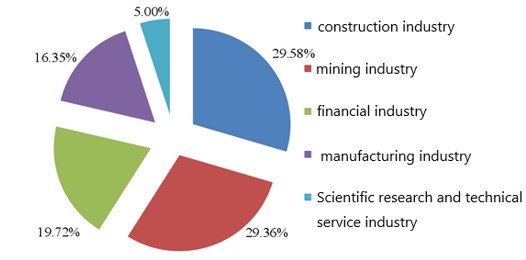A Comparative Study on the Relocation of Chinese Manufacturing Industries to ASEAN, Africa and South Asia
Main Article Content
Abstract
This paper explores the differences between China and ASEAN manufacturing environments through the study of the relocation of Chinese manufacturing to ASEAN. In view of the phenomenon of a large number of Chinese manufacturing industries relocating to ASEAN, this paper will analyze the advantages and crises brought by the manufacturing environment of China and ASEAN. This paper interprets it through literature research. The results of the research confirm that China's low-end manufacturing enterprises have already begun an irreversible outflow, and ASEAN is more attractive than Africa and South Asia in terms of land and manpower. Although the manufacturing transfer has certain drawbacks, it is still a win-win situation for China and ASEAN. ASEAN should raise the upper limit of market access, relax financing policies, increase fiscal and taxation support, and provide relevant citizen benefits, while China should also encourage companies to invest and start businesses abroad, so as to achieve positive interactions brought in by going global. The research in this paper can help governments and investors in China and ASEAN to make rational decisions.
Article Details

This work is licensed under a Creative Commons Attribution-NonCommercial-NoDerivatives 4.0 International License.
Supply Chain and Sustainability Research uses a Gold Open Access model. All articles at Supply Chain and Sustainability Research are published Open Access. Publication is funded by a fee paid at the time of acceptance (Publication Fee). From June 2020 onward, author(s) retain copyright of their work, with articles licensed to the publisher Southeast Bangkok College and Supply Chain and Sustainability Research. All articles published on this site use the Creative Commons Attribution 4.0 License (CC BY 4.0). You do not need to seek permission from Supply Chain and Sustainability Research or Southeast Bangkok College for reuse of contents published on this site.
This means;
All articles are immediately available free-of-charge upon publication.
Copyright on all Open Access articles in Supply Chain and Sustainability Research is retained by the author(s), or the author's Employer.
Author(s) grant Southeast Bangkok College a license to publish the article and identify itself as the original publisher.
Author(s) also grant any third party the right to use the article freely as long as its integrity is maintained and the original authors, citation details and publisher are identified.
You are free to:
Share — copy and redistribute the material in any medium or format
Adapt — remix, transform, and build upon the material for any purpose, even commercially.
Under the following terms:
Attribution — You must give appropriate credit, provide a link to the license, and indicate if changes were made. You may do so in any reasonable manner, but not in any way that suggests the licensor endorses you or your use.
No additional restrictions — You may not apply legal terms or technological measures that legally restrict others from doing anything the license permits.
There may be exceptions to copyright and licensing for articles which were previously published under policies that are different from the above, in this case different licensing conditions may then apply. If in any case Supply Chain and Sustainability Research contains material republished with permission under a different license, you may need to seek permission for reuse from the copyright holder. In all such cases, however, access to these articles is free from fees or any other access restrictions.
Open Access ensures the widest possible access to research, makes research available to wider audiences, allows readers to use articles and data, and also allows author(s) to distribute their works freely. Open Access accelerates research by removing barriers to collaboration and accelerates scientific communication.
If you require more information, please don't be hesitated to contact the Editorial team anytime here or contact the Editorial Office below.
References
Alice, C. (2017). How long will the recovery of Sany Heavy Industry last? [EB/OL]. https://news.d1cm.com/2017050290005_1.shtml, 2017-05-02.
Li, P.F. (2017). Sany Heavy Industry Revitalizes Over 10 Billion Yuan of Stock Assets, Diversified Transformation Out of Industry Lows [N]. Changsha Evening News, 2017-01-11 (A10).
Li, X., & Zhou, X. Y. (2012). China's investment in African manufacturing: problems and countermeasures [J]. International Economic Cooperation, (7), 57-61.
Li, Y.Q. (2013). Negative growth of labor force [J]. Development, 8, 22-24.
Luo, X. Z. (2011). Where is the future of China's manufacturing road [J]. Modern Enterprise Education, 1, 64-65.
NCBS., BSGZA, & GSTNBS. (2018). Statistical Yearbook of my country-ASEAN Countries [M]. China Statistics Press: China, 51.
Chen, G. (2017). Think Like Anbang: Understanding China and the World [M]. China Finance and Economic. China Finance and Economics Publishing and Media Group, 150.
Qin, R., & Cao, Z. (2018). ASEAN Investment Environment and Business Opportunities [R]. Singapore: China Business Research Center. National University of Singapore Business School.
Qiu, R. R., Zhao, Y., & Yao, S.G. (2007) Research status of advanced treatment and reuse technology of printing and dyeing wastewater [J]. Industrial Water Treatment, 9, 1-5.
Tang, Y. H. (1985). Development and Industrialization Strategy of African Manufacturing Industry [J]. West Asia and Africa, (1), 25-30.
Wang, J. Y. (2019). The measurement of intra-industry trade between China and ASEAN and its influencing factors [D]. Citation: Bhowmil R,ZhuY, Gao K (2021) An analysis of trade cooperation: Central region in China and ASEAN. PLoS ONE 16(12): e0261270. https://doi.org/10.1371/journal.pone.0261270
Xiao, J.J., & Yang, W.W. (2018). Research on manufacturing capacity cooperation in the construction of "One Belt One Road" [J]. Qinghai Social Sciences, 234(06):37-42+90.
Yang, S. L., Ye, Y., & Lv, X. (2018). Research on the symbiotic relationship between China and South Asia's manufacturing capacity cooperation [J]. Future and Development, 042(005), 35-39.

